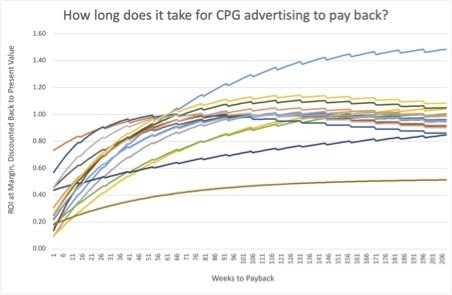The question “how long does it take for advertising to pay back?” is a pertinent one for marketers currently. With many consumers enduring a cost-of-living crisis and many businesses wary of a recession, marketing budgets are being scrutinised for potential cost savings. Advertising budgets are a big and obvious target for cuts, particularly if the return on investment is deemed to be lacking. But should they be?
The CPG industry, or FMCG if you prefer, is an interesting sector to analyze. Precise data about the amount CPG brands spend on advertising is hard to come by. According to one report, they account for 6.7% of total ad spend in the US. What we do know is that, historically, this media supports CPG companies’ listings, helps favourable positioning on shelves, makes innovations easier to launch in store, supports brand awareness and, in some cases, the company’s stock price as well.
But we also know that CPG advertising rarely pays back in the short term – that’s to say the period that an ad is live and roughly 2-3 months after. To demonstrate this, it is important to use the right metric. I recommend analyzing the ROI at margin – a metric that applies a profit margin to the incremental revenue delivered by advertising. Using this, we take account of all the costs associated with an uplift in sales to deliver a truer picture of how advertising impacts the bottom line. Gain Theory data, based on the performance of over 200 brands over the last few years, shows that the average short-term ROI at margin is only 0.43. The minimum is 0.12, while the maximum is 0.96.
This is problematic given most marketers – over two-thirds in the US – use return on advertising spend to measure campaign outcomes and determine future ad spend. If the campaigns they are measuring do not pay back over the short term then they risk making crucial decisions based on sub-optimal data. The question is, how long does it take for CPG advertising to pay back?
A longer than expected payback
 To find out, we lent on our expertise in advanced analytics and decades of experience working with CPG brands to study food and drink companies in Europe and North America. Using a statistical model – distributed lags within an unobserved components analytics framework – we were able to project how the impact of an initial response to this group’s advertising is spread out over time. A key consideration when doing our analysis, which used data from January 2022 onwards, was using an appropriate discount rate to convert future income streams from advertising back to present value.
To find out, we lent on our expertise in advanced analytics and decades of experience working with CPG brands to study food and drink companies in Europe and North America. Using a statistical model – distributed lags within an unobserved components analytics framework – we were able to project how the impact of an initial response to this group’s advertising is spread out over time. A key consideration when doing our analysis, which used data from January 2022 onwards, was using an appropriate discount rate to convert future income streams from advertising back to present value.
The chart below reveals our findings, with each line representing a brand in one country. On average, it takes 94 weeks for CPG advertising to deliver a positive return at margin. This means that a campaign that ran in the Summer of 2022 could still be having an impact in Spring 2024. The earliest payback is 61 weeks, meaning even the best-performing brand does not see a return within a year. The longest payback period – for a large brand in a stable, mature (ie, low-growth) market – is 150 weeks.
It’s important to note that the greater the profit margin, the quicker the advertising pays back. Equally, when the lines begin to dip down they are still contributing a return, albeit in small quantities. However, the further we go into the future, the harder the discount rate bites.
The study threw up other interesting findings. It confirmed that more creative ads have both a stronger short-term ROI and pay back more quickly over the longer term. More worryingly, brands in mature, low-growth markets and a small number of large brands struggle to generate a return from advertising over a two-year timeframe unless it is backed by new product development into adjacent markets. As always, size also matters. With a couple of notable exceptions in high-growth categories, the bigger the brand, the quicker the advertising pays back.
Gaining confidence
The most important takeaway is that advertising does boost the bottom line of CPG companies in the majority of cases. But this needs to be tempered by the fact that it does not happen in the short term – in many cases it takes longer than a year.
Of course, some brands never see a return on their advertising. In these instances, ad spend should be cut unless there is definitive proof that this would see the brand de-listed, re-positioned on shelf, or suffer other adverse consequences.
Overall, however, CPG brands must be cognisant of the fact that while cutting advertising budgets can be an easy source of cost savings, they risk sacrificing revenue and profit both now and in the future. Armed with this knowledge, marketers can have confidence when having conversations with senior stakeholders that budgets should be more protected.
Contact Jon to understand what the advertising payback is for your brand.
This article was originally published on Warc’s website. Click here to view.
